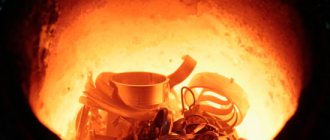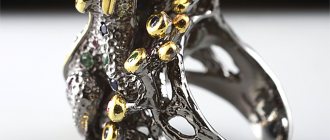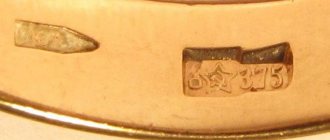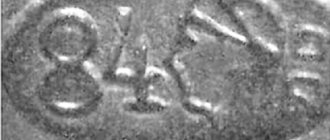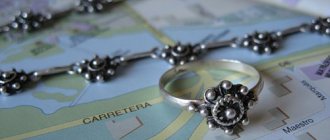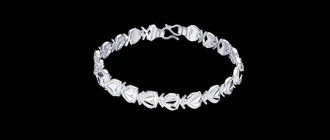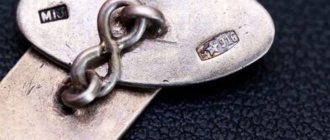Silver is used not only in jewelry, but also in industry, due to the physical and chemical properties of this metal. Therefore, many are interested in such qualities as the melting point of silver, its thermal conductivity and resistance. Silver can be found in microcircuits, resistors, relays, and batteries. This metal is used more often than gold because silver is cheaper and easier to mine.
Cleaning silver jewelry with baking soda
Characteristics and properties of metal
Silver was discovered more than 6,000 years ago.
This is evidenced by archaeological finds in Egypt, Turkey and Iran. Since ancient times, it has sometimes been called moon metal. In many cultures, the silvery-white color of this material is associated with the cold shine of the night star. There were times when this white noble metal was valued even more than gold. In Latin, silver is called “argentum”, in other words, “light, white”. The density of lunar metal is 10.5 g/cc, that is, argentum is heavier than iron (7.87 g/cc), but much lighter than gold (19.3 g/cc). Silver is a soft and ductile metal that has exceptional characteristics compared to other materials:
- highest thermal conductivity;
- the highest electrical conductivity;
- it has no equal in terms of reflectivity.
The melting point of the noble metal is 962 °C, boiling point is 2212 °C. However, it must be borne in mind that in a chemically pure state, silver is almost never used. It is used in the form of alloys with a so-called master alloy, which improves the technological and operational properties of the material. Copper is most often used as an alloy, as well as nickel, zinc, aluminum and other metals. The sample indicates the proportion of noble material in the alloy. For example, 830-grade silver contains at least 830 g of pure substance per 1000 g of alloy. Depending on the sample, the melting temperature also changes: from 962 °C to 780 °C.
Separation of silver from impurities
Silver must be cleaned of impurities in several stages.
The method proposed by chemists for purifying metal from minor components consists of a developed technological chain. It is recommended to carry out the cleaning procedure outdoors in several stages:
- The alloy is placed in a container made of material that does not react with nitric acid. The alloy filled with acid reacts by heating and releases an unpleasant odor. In this case, the liquid turns copper-colored.
- After cooling, a solution of kitchen salt must be poured into the resulting substance to precipitate the lunar metal. Silver chloride does not react with acid, so it will settle to the bottom as a white powder.
- It is necessary to repeatedly add clean water to the container until the water becomes clear.
Technical and jewelry silver
For technical purposes, the most important are the maximum indicators of reflectivity, electrical and thermal conductivity. The melting point of real silver is also of greatest importance. Therefore, it must be at least 999th standard. But for jewelry, strength, hardness, wear resistance, and good casting properties are more important. The most common jewelry alloys:
- 960 sterling silver contains 96% of this material, is very soft and ductile, and is used in highly artistic elements of exquisite jewelry that are not subject to mechanical stress. Melts at 900−940°C.
- The 925 alloy is called sterling silver, or standard silver; it has a dazzling white color, excellent wear resistance and strength; coins were previously minted from it. Now this jewelry alloy has become most widespread in the production of various jewelry (chains, bracelets, rings and earrings), fine cutlery and dishes. The melting point of 925 silver is 810−940°C.
- The 875th sample of lunar metal is used in the manufacture of cutlery, spoons, forks, and jugs. For jewelry, this silver is considered to be of insufficient quality, since a significant copper content worsens the appearance of the jewelry.
- The 800-karat alloy is mainly used in writing and cutlery, it is highly wear-resistant and has a yellowish tint. In Russia, this indicator for silver is considered minimal. Melting of lunar metal of 800 standard occurs at 779−820°C.
According to the data in the table, you can find out at what temperature silver of different samples melts.
| Try | Density, g/cm3 | Melting area, ºС | Tensile strength, kgf/mm2 | Relative extension, % |
| 999 | 10,39 | 960 | 18 | 49 |
| 960 | 10,35 | 900 — 940 | 22 | 35 |
| 925 | 10,29 | 810 — 910 | 30 | 29 |
| 900 | 10,30 | 779 — 890 | 30 | 26 |
| 875 | 10,16 | 779 — 870 | 30 | 33 |
| 800 | 10,13 | 779 — 820 | 31 | 30 |
Melting temperature
To start making various products from noble metal, you need to understand the melting temperature of silver. It directly depends on its composition, percentage of base, impurities:
- Sample 925 - melting point about 962 degrees Celsius.
- Sample below 925 - melting at about 770 degrees.
- Boiling point - 2210 degrees.
To melt this noble metal, it is necessary to take into account a number of nuances and follow safety regulations.
Master melts silver
Melting at home
In order for the melting to take place correctly, you need to do some work first. You need to make your own or purchase a crucible (melting container). You will also need a gas or gasoline burner, heat-resistant tongs, scales, and a mold for pouring liquid silver.
Batch preparation
The charge is a mixture of melted metal and borax. In order to speed up the process of transition of the material from solid to liquid, you must first break the silver items into small pieces using pliers. Then prepare the mixture in the correct ratio between metal and borax. For 10 parts by weight of the charge there should be 1 part of borax.
This substance is necessary to protect the melt from impurities of oxides of other metals and from oxidation by oxygen. In addition, borax improves the sliding of liquid along the walls of the crucible.
Melting process
At home, it is especially important to ensure safety. There should be no flammable substances or flammable objects in the workplace. And it is also necessary to ensure effective ventilation. Eyes should be protected with special goggles, hands with thick gloves. And that's why.
Silver in the molten state absorbs oxygen very strongly. For every unit volume of metal there are 20 units of oxygen. When the melt begins to solidify, the gas dissolved in it violently releases out, breaks the hard crust that has formed on the surface and is sprayed around in beautiful and extremely dangerous high-temperature jets and drops.
The prepared mixture is loaded into a well-heated crucible and then heated using a burner until it completely turns into liquid. In this state, the surface of the molten metal should be shiny like mercury. If the surface does not shine, it means that the silver has not yet completely melted.
Receiving castings
The liquid metal can be left to solidify in a crucible, then after solidification an ingot will be obtained in the shape of the inner surface of the vessel. If you need a specific casting configuration, then before you melt the silver, you need to make a mold. The contents from the crucible should be poured into it.
The more sophisticated the casting profile, the more difficult it is to make a mold for it. This requires special knowledge and experience. If the stock of erudition can be replenished from various sources (textbooks, reference books, the Internet), then the necessary skills are acquired only through practical actions.
It is possible to melt silver at home, but the result will depend on how complex the casting needs to be. If it’s just a pig, no matter what shape, then it’s not difficult. And if the end result is an elegant decoration, then it is better not to melt it at home.
Application area
Affordable cost, ductility and ease of processing allow the metal to be used in industry and everyday life. The most common applications are as follows:
- production of jewelry, various decorations in combination with other metals, precious and semi-precious stones;
- production of original tableware;
- multilayer ceramic capacitors, relay contacts;
- as part of the cathodes of galvanic cells;
- minting of coins, special awards, orders;
- application in climate control in an alloy with silver iodide;
- as a coating for original handmade mirrors;
- as a catalyst in oxidation reactions.
In addition, humanity discovered the disinfecting properties of metal several centuries ago. In Ancient Rome and Persia, water was stored in silver vessels for important gentlemen, military men, and soldiers.
It is worth noting that in jewelry they often used not pure material, but its alloy with copper or other types of raw materials. It was then that the craftsmen began to be interested in the topic of melting silver at home, because most of them worked at home.
Why melt silver
Many people do not suspect that precious metal surrounds us everywhere. About 80% of global silver production comes from the industrial sector, with the remainder from banks and jewelry.
Lunar metal is found in radio components, batteries, contacts, capacitors, coins, cutlery, and jewelry. Even the average user's computer or laptop contains about 1 gram of precious metal.
By melting silver, you can create an analogue of a bank ingot or a unique dyeing with your own hands. If you have accumulated a lot of silver items at home that can no longer be useful, you should not rush to throw them away.
Precautions for smelting operations
Foundry processes require increased safety precautions. There should be no flammable substances near the isolated work area. You should not skimp on protective equipment; you should definitely purchase glasses with protective glass on a garter, an apron, gloves, and work clothes.
Clothing must cover the entire body, since even a drop of hot precious metal can burn a section of skin to the bone.
You can also purchase a fire extinguisher to prevent a fire.
Homemade silver smelting
How raw materials are processed
The raw materials for obtaining the substance can be scrap of precious metals, industrial waste, or mined ore. To extract the precious metal, the following processing steps are applied step by step:
- Grinding. Recycled raw materials are crushed to obtain a fine mass.
- Firing allows you to remove flammable debris from the composition.
- Centrifugation is the separation of molten silver from other metals except lead.
- Remelting. During the cooling process in the crucible, liquid lead is separated from the noble metal, which solidifies faster.
- Electrolytic processing. The precious metal, dissolved in nitric acid, is exposed to electricity, causing the anode to attract impurities and silver to crystallize around the cathode.
- Chemical treatment allows you to obtain a substance of 1000 samples. The noble metal is dissolved using sulfuric and hydrochloric acids and ferric chloride, precipitating it with zinc. Silver is released from the solution in the form of sand, which is washed and remelted.
At what temperature does it melt?
Depending on the sample and alloy composition, the precious metal changes its melting point, which decreases in proportion to the mass fraction of the precious element in the alloy.
| 800 sample | 780–820 °C |
| 875 sample | 780–870 °C |
| 900 sample | 780–890 °C |
| 925 sample | 810–910 °C |
| 960 sample | 900–940 °C |
| 999 sample | 960 °C |
What metals are used in silver alloys, how do they change the melting point
In the jewelry industry, copper is used as a ligature component. The temperature of the alloy decreases in proportion to the sample.
Platinum is used as an alloy in the creation of high-precision instruments. The melting point of such a metal ranges from 1000 °C.
An alloy of silver and palladium is widely used in dentistry. At a sample of 820 and above, the melting point of such an alloy is 1100 °C, however, a further decrease in the sample also lowers the melting point.
In electronics, alloys of technical silver with cadmium and tin are used as solders. Their melting point can range from 400 to 850 °C.
Basic properties of silver
The high thermal conductivity and low electrical resistance of the metal in question allows it to be actively used in a variety of fields. Based on it, in particular, they make:
- cleaning elements for both air and water filters;
- resistors;
- microcircuits;
- contact groups of electromechanical relays, etc.
Silver is also in great demand among jewelers. According to statistics, this metal is much more popular than gold. This is primarily due to large production volumes and relatively low cost.
Silver is not without its drawbacks. In particular, it has:
- excessive softness in its pure form;
- tendency to oxidation.
Another important property of the precious metal is its high reflectivity, amounting to 95 percent. Because of this, silver is often used in the manufacture of mirrors.
Its density is ten times greater than that of water (10.5 grams per cubic centimeter). Such a unique indicator makes it possible to produce very current wire or foil. Both are very actively used by jewelers and interior designers.
During crystallization, which is already achieved at 960 degrees, the floating temperature is 962. This specificity requires great care of the master.
The Brinell hardness of silver is 25 units.
The specific temperature (heat) of fusion ranges from 87 to 105 kilojoules per kilogram.
Preparation
We would like to warn you that melting silver items in an apartment is unsafe. You can easily get burned and even start a fire. So prepare carefully for this procedure and remember to take precautions.
To melt silver you will need:
- metal spoon,
- sheet asbestos,
- borax,
- burner,
- tweezers,
- forceps,
- gypsum,
- white quartz sand.
Before you begin, place all the items and ingredients you need on your work surface. Try to remove everything unnecessary so that nothing interferes with you while working. Wear clothes made of thick material. Protect your hands with gloves and your eyes with special glasses with elastic that fit well to your face. It is advisable to leave as little surface of the skin as possible exposed to minimize the risk of accidental burns.
Prepare a mold for casting silver (ingus) in advance. To make it, you will need quartz sand and gypsum. If you know dentists, then with their help you can get a lithium mixture that is used in dentistry. In addition, beeswax will also come in handy. Use it to create a model of a future piece of jewelry. Place this model in a container with a mixture of gypsum and pure quartz sand. While the mixture has not completely hardened, make a narrow recess into which you will pour the melted silver.
Once the mixture has completely hardened, warm up the ingus. If you work inside, be sure to open the window and turn on the hood. When heated, the wax begins to evaporate, giving off a very unpleasant odor. The disappearance of the amber will be a signal that the form has already been completely cleared of wax and is suitable for use. Now you can begin the main process.

